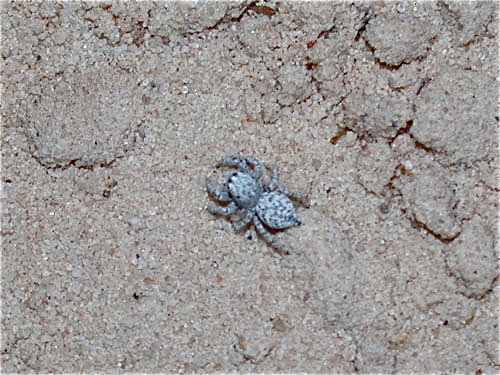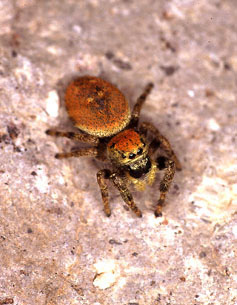
Spiders that Jump and Dance
David B. Richman
Mesilla Park, New Mexico, USA
I have studied spiders for nearly 50 years now, and have been a professional arachnologist for over 30 of those years. From the first I was intrigued by the visually talented jumping spiders (Salticidae) and thought that I would work primarily on their behavior. Unfortunately in 1961, when I started to become interested in these (to me) fascinating creatures, the last major revisionary work on the North American fauna had been published in 1909! The taxonomy was a muddle, with only a few generic revisions and these were over 5 years old at best. There were in fact a number of species that had not been described and named officially. One other problem immediately presented itself and that was that in several of the more sexually dimorphic named species, the other sex was unknown. This was especially so in the genus Habronattus, known then as Pellenes, which still is recognized as a valid genus, but with many fewer members. Early on I started to write to the dean of spider researchers at the time, Willis J. Gertsch of the American Museum of Natural History, and later to several amateurs (one, Bruce Cutler, later became professional) who were also interested in the family. I amassed a reference collection of specimens and obtained as much of the then available literature as I could. Through a series of happy accidents and a bit of hard work I got my Ph.D. in invertebrate zoology under Dr. Jon Reiskind at the University of Florida in 1977 and was hired on as a post-doctoral student of the arachnologist and biological control researcher Dr. Willard H. Whitcomb. I was later hired by New Mexico State University, in Las Cruces, New Mexico, to do biological control research and eventually to curate the Arthropod Museum. I only mention the above background to warn the reader of my biases.
To get to the spiders themselves, they are quite fascinating creatures, at least from my biased perspective. Over 5000 species are known worldwide, making the Salticidae the largest known family of spiders. Like many diverse organisms, they are more speciose in the tropics and they seem to be primarily an early Tertiary development, with possible roots in the late Cretaceous. The characteristic box-like cephalothorax with eyes in three to four rows (total eight eyes, as in most spiders) and highly enlarged anterior medial eyes identify a jumping spider. In addition most, if not all, can be forced to jump even if they are ant mimics that do not normally do so. Their excellent vision (apparently only second to cephalopods among the invertebrates) allow them to both hunt and court visually, but that is not the whole story. Their tubular anterior medial eyes employ a fixed clear cuticular lens and scanning is accomplished by moving the retinae with a set of muscles. Because the eye is tubular, the focus is fairly broad. The retinal cells seem to be primarily sensitive to the green and UV sections of the spectrum, and they do not seem to see red. Despite this they can distinguish both color and shapes, but vision is not their only sense. They also feel vibrations and can make high-pitched sounds during courtship. In a few species the males can pick up chemical cues from female silk draglines.

Paraphidippus basalis from New Mexico.
Courtship is varied- from sequestering penultimate females in their molting sac and mating with them just after their molt, to elaborate courting rituals employing both visual and auditory displays. Salticid males may be as elaborated ornamented as birds of paradise and have as complicated a ritual. Habronattus hallani displays iridescent undersides of the femora of the first two pairs of legs by suddenly jumping at the end of a lateral run, the run being repeated in a zig-zag as the male approaches the female. Neonella vinnula, a tiny jumping spider at 1.5 mm in length, vibrates the entire body and slowly creeps forward. Habronattus pyrythrix males also creep slowly forward, but display the greenish fringes on their forelegs and raise and lower the third legs, displaying markings and knobs on the patellae. Courtship may last thirty minutes or more in Habronattus, but may be relatively rapid in the same genus and in other genera. In Habronattus at least, the male may accompany his visual display with tapping of the palpi and the rubbing of other body parts. In some species the sound, made audible to human ears sounds like a drum riff for a rock and roll band! In recent times a mystery that had began in the 19th Century was finally solved and led to the discovery of one of the most bizarre courtships known. Maratus volens (once known as Saitis volens), which had extendable flaps on the abdomen, was thought to glide, much like the so-called flying lizards, snakes and frogs. Unfortunately only the male was known. I (and other salticid specialists) suspected that the flaps functioned in courtship and this was confirmed recently when a related species was filmed (see: Otto & Hill 2010). This courtship is very similar to displays of the peacock and some birds of paradise. The field of jumping spider courtship is still wide open, as most species have never had their courtship recorded. Almost no work has been published on female behavior during courtship, although in a few, like Naphrys pulex, the females seem to actively take part in the display. In addition at least some species have distinct agonistic (dominance) display between males, which in some genera (for example Hentzia and Anisaitis), can lead to fighting with the chelicerae. Others, most notably males in most species in the genus Habronattus, seem to hardly notice each other.

Naphrys pulex, female, Oklahoma.
In prey capture jumping spiders resemble cats, if one can imagine an eight-legged cat with a silk dragline being exuded from spinnerets at the tip of the abdomen. They stalk their prey and can loose sight of it, only to emerge at the spot where it was last seen, as Hill reported in his elegant study on Phidippus prey capture behavior. Some, like members of the amazing genus Portia, are able to vary their tactics, depending on the prey. Portia will eat insects occasionally, but it much prefers other spiders. It uses web plucking to draw web-building spiders down from their lairs and will vary the pattern depending on result. The behavior of Portia was well reported by Robert R. Jackson and his research team at the University of Canterbury in Christchurch, New Zealand. For other jumping spiders it may even start a sort of generalized courtship and then pounce on the unfortunate victim, piercing it with the fangs of its chelicerae. Some jumping spiders, like Naphrys pulex, are specialists in ants (interestingly ant mimics do not seem to usually be ant-feeders.)

Habronattus sp. immature, White Sands National Monument, New Mexico
Mimicry seems to be common in the Salticidae, with many ant-mimics, velvet-ant mimics, and possible leaf beetle mimics. None of these seem to be Peckhamian or aggressive mimics and there is no evidence that most are as potent as their models. The one exception may be the velvet-ant mimics like Phidippus apacheanus, which has (as I once discovered) a very painful bite, very much like the sting of a velvet ant! Thus most are probably Batesian mimics (mimicry in which the model is venomous or poisonous to eat and the mimic is non-venomous or non-poisonous), with P. apacheanus a possible Müllerian mimic (a case of mimicry where both model and mimic are venomous or poisonous to eat – the mimicry rings of several families of butterflies in the Amazonian region come to mind.) Some of the best-known ant mimics are in the genus Synemosyna, which mimics stem-nesting ant in the genus Pseudomyrmex. Most of the species live in the American tropics, but one, S. formica is found in the eastern United States. Another species is known from Florida. These jumping spiders are so ant-like that they can fool even specialists. I have discussed ant and beetle mimicry in another article and I refer the reader to that reference.
How did this family become so successful? It seems that they, like several other taxonomic groups, (orchids and some tropical birds, as well as diatoms, come to mind) speciated wildly during the very warm early Tertiary and later, leading to a complexity of form and behavior that almost boggles the mind. Obviously their keen eyesight must have had a major role in their success. Their ancestors from the Creataceous were probably either the crab spiders (Thomisidae and Philodromidae) or one of the so-called “clubionoid” families like the Anyphaenidae. Once they got going the salticids invaded many, if not most terrestrial habitats, being found high in the Himalayas and in the intertidal of Southeast Asia. A jumping spider was one of the first animal colonists found on Krakatau after the explosive eruption in the 19th Century and they made it to both the Galapagos and Hawaiian Islands before Europeans arrived. The genus Sandalotes in Hawaii has even speciated on the Hawaiian Islands, much like Darwin’s finches in the Galapagos.

Phidippus apacheanus, female, New Mexico
Jumping spiders are remarkable creatures and well worth the knowing. I would encourage any microscopy hobbyists who are interested in the larger “micro” forms (some jumping spiders are as small as 1 mm long, some as large as 20 mm) to consider these fascinating spiders for extended study. A binocular dissecting microscope is a necessity for examination of the anatomy (with includes the study of the modified setae or hairs, which have morphed into often brightly colored or metallic scales, especially in the males). Observations of the behavior are much needed and only a few professionals have the time or grant money to record courtship, agnostic display, prey capture, life histories or biodiversity for a local area.
Comments to the author David Richman are welcomed.
References
Hill, D. E., and D. B. Richman. 2009. The Evolution of Jumping Spiders: A Review. Peckhamia, 75.1, 1-7. http://peckhamia.com/numbers.html
Jackson, R. R. and R. S Wilcox. 1998. Spider-eating spiders. American Scientist, 86: 350-357.
Richman, D. B. 2000. Ants, beetles and Spiders. Micscape, Feb. 2000. http://www.microscopy-uk.org.uk/mag/art00/drspider.html
Richman, D. B. 2008. Jumping spiders (revised). In J. L. Capinera ed. pp. 2066-2068 in Encyclopedia of Entomology 2nd ed. Kluwer Academic Press.
Richman, D. B., G. B. Edwards and B. Cutler. 2005. Salticidae. In: Spiders of North America. Ubick et al. ed., American Arachnological Society, 205-216.
Richman, D. B., and R. R. Jackson. 1994. The Ethology of Jumping Spiders. Bulletin of the British Arachnological Society.
Wilcox, S. and Jackson, R. 2002. Jumping Spider Tricksters. In Bekoff, M., Allen, C., and Burghardt, G.M.. The Cognitive Animal: Empirical and Theoretical Perspectives on Animal Cognition. MIT Press. pp. 27–34.
Otto, J. C. and D. E. Hill. 2010. Observations of courtship display by a male Maratus amabilis Karsch 1878 (Araneae: Salticidae). Peckhamia 79.1: 1-16. http://peckhamia.com/numbers.html
Published in the
October 2010 edition of Micscape.
Please report any Web problems or
offer general comments to the Micscape
Editor.
Micscape is the on-line monthly magazine
of the Microscopy UK web
site at Microscopy-UK